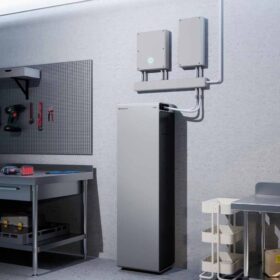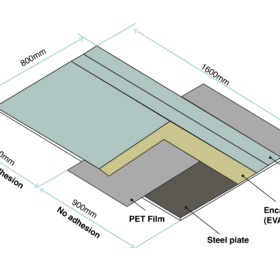PV-driven water splitting system with solar-to-hydrogen efficiency of 9.8%
Scientists in Korea have built a green hydrogen system prototype that embeds a PV generation unit based on photoanodes made of perosvksite solar cells. The device purportedly achieved a solar-to-hydrogen efficiency of 9.8% for a device with a size of 0.25 cm2, and 8.5% for a system measuring 123.2 cm2.
Brite Energy Partners, LG Innotek sign 84.7 MW deal in South Korea
LG Innotek will secure electricity and supply renewable energy certificates (REC) under a 20-year fixed-price agreement, procuring 100 GWh of renewable energy per year.
The Hydrogen Stream: Mitsui tests MAN B&W engine on hydrogen
Mitsui and MAN say they have converted a gas injection engine to hydrogen for the maritime industry, while 3M and HD Hyundai Korea Shipbuilding & Marine Engineering (KSOE) have agreed to develop large liquid hydrogen storage tanks.
Korean scientists build semi-transparent perovskite solar cell with record-breaking efficiency of 22.02%
Developed by researchers at the Korea Institute of Energy Research (KIER), the novel cell was conceived for applications in bifacial perovskite-silicon tandem PV devices. The academics claim they were able to overcome an intrinsic dopant-induced internal degradation mechanism which leads to undesired lithium-ion diffusion that would have been detrimental to the cell efficiency.
VSun Solar signs polysilicon supply deal with OCI
OCI has agreed to supply polysilicon to Toyo Solar, the cell production subsidiary of VSun Solar, in order to support wafer production.
Green hydrogen, power generation tech based on compressed air storage, solid-oxide electrolysis cells
Scientists in Korea have developed a compressed air storage system that can be used as a combined cooling, heat, and power system and provide heat and power to solid-oxide electrolysis cells for hydrogen generation. It showed an overall roundtrip efficiency of 121.2% and over-unity efficiencies in the range of 100% to 120%.
LG launches new residential storage solution
LG has developed two versions of its new enblock E storage system, each with usable energy capacities of 12.4 kWh and 15.5 kWh. It says the two models, sized at 451 mm x 330 mm, can be easily deployed in small spaces.
Silver-alloyed CIGS solar cell achieves 17.7% efficiency
Developed by scientists in Korea, the so-called ACIGS cell is intended for applications in perovskite-CIGS tandem PV devices. Their work demonstrates correlations between element diffusion behavior and notch-point formation in ACIGS films.
South Korean researchers develop 19%-efficient stretchable organic PV cells
The Korea Advanced Institute of Science and Technology (KAIST) says its new organic PV cells are suitable for wearable electronics. KAIST claims that the cells can be stretched by up to 40%.
Korean researchers explore viability of BIPV panels based on steel plates
A team from South Korea’s Research Institute of Industrial Science and Technology (RIST) has developed a new method to increase the adhesion performance of EVA and POE on steel plates. The proposed technique may be applied to BIPV modules that use steel panels instead of backsheets.










